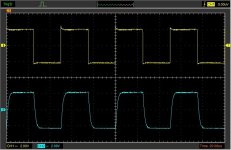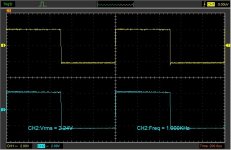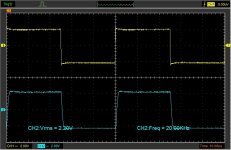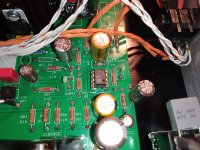LME49720 & OPA2604 do not oscillate without C2&C7, no compensation is required. When even 22pF is added for compensation, the LME49720 oscillates.
The OPA1612 does not oscillate only if a Zobel network 10ohm+47nF is added to the output. Compensation even with 22pF causes oscillations with or without a Zobel network, so this OPA should be used without compensation.
The OPA1612 does not oscillate only if a Zobel network 10ohm+47nF is added to the output. Compensation even with 22pF causes oscillations with or without a Zobel network, so this OPA should be used without compensation.
As for the listening test, the LME49720 has a slightly flat and dry sound with thinner bass than the Muses 02. The SS3602 and the Muses 02 are as described by @mikorist . Muses 02 have softer sound, a bit bassy. SS3602 have very realistic sound with a lot of details, but it might be tiring for some people after long listening. Sparkos is there to be listened to intensively for a couple of hours, and then the device should be turned off. 🤣
I haven't listened to the other OPAs. I will probably do that on the next copy. It is not easy to judge which is the best, because a lot depends on the headphones themselves.
A similar sound character remained when the Whammy was used as a Line preamp. I was just bothered by too much gain in my system, so I'll probably make my copy with less gain, 3x is enough. A direct comparison with the Aikido 6N6P tube buffer reveals that the Whammy has a more dynamic in the bass region and slightly rougher sound in treble region, and the tube buffer is more transparent with more "air" in the sound but less bass and dynamics in those lower registers. The midrange is similar on both devices. Sound spatiality and 3D presentation are excellent on both devices, the Whammy has perhaps a slightly more centrally positioned soundstage than the Aikido. Each device needs at least 30 minutes to warm up and play at full capacity, so I had to keep them on all the time for testing.
I haven't listened to the other OPAs. I will probably do that on the next copy. It is not easy to judge which is the best, because a lot depends on the headphones themselves.
A similar sound character remained when the Whammy was used as a Line preamp. I was just bothered by too much gain in my system, so I'll probably make my copy with less gain, 3x is enough. A direct comparison with the Aikido 6N6P tube buffer reveals that the Whammy has a more dynamic in the bass region and slightly rougher sound in treble region, and the tube buffer is more transparent with more "air" in the sound but less bass and dynamics in those lower registers. The midrange is similar on both devices. Sound spatiality and 3D presentation are excellent on both devices, the Whammy has perhaps a slightly more centrally positioned soundstage than the Aikido. Each device needs at least 30 minutes to warm up and play at full capacity, so I had to keep them on all the time for testing.
Last edited:
I bought popcorn to watch your copy put together. . Because I know you have all possible Bursons, Sparkos and other opamps.🤣I haven't listened to the other OPAs. I will probably do that on the next copy.
100uF &100 uF Low ESR caps added in parallel to C26 & C27. The result is that the lower cutoff frequency has dropped from 8Hz -3dB to 1.5Hz -3dB.
The input signals from the potentiometer are fed directly to R2 & R7 and the cable shields to the grounded ends of R3 & R5. I did not use input capacitors, everything is DC coupled.
When the potentiometer slider is on GND (0R - min. volume) output DC offsets are -0.7 to -0.8mV. When the pot slider is in the end position (50k - max. volume) the output DC offsets are +3.1 to +3.2mV (with the Muses 02).
Quiescent current on both channels is 58mA and does not change with heating.
The input signals from the potentiometer are fed directly to R2 & R7 and the cable shields to the grounded ends of R3 & R5. I did not use input capacitors, everything is DC coupled.
When the potentiometer slider is on GND (0R - min. volume) output DC offsets are -0.7 to -0.8mV. When the pot slider is in the end position (50k - max. volume) the output DC offsets are +3.1 to +3.2mV (with the Muses 02).
Quiescent current on both channels is 58mA and does not change with heating.
Attachments
Last edited:
The amplifier plays better and better as time goes by. It's unbelievable what comes out of this.🤣
Any op-amp can be considered suitable if it provides prolonged listening without causing fatigue. If you can listen for two hours without feeling bored or fatigued, then it is a good choice for your needs.But, compared to all these wonderful opamps, what do you think of the good TL072?
I have a curiosity:
The Whammy circuit does not include bypass capacitors on the operational amplifier and on the lm7815 lm7915 regulators.
Some time ago I made a headphone amplifier with lme49720 and lm49600 as buffer
Great attention has been given to bypass capacitors.
Since someone has had these problems, wouldn't it be better to fix it first?
The Whammy circuit does not include bypass capacitors on the operational amplifier and on the lm7815 lm7915 regulators.
Some time ago I made a headphone amplifier with lme49720 and lm49600 as buffer
Great attention has been given to bypass capacitors.
Since someone has had these problems, wouldn't it be better to fix it first?
Boh, I don't know
I don't see small ceramics here and there...
I'm definitely wrong, but if it was done another way I'd like to understand.
I don't see small ceramics here and there...
I'm definitely wrong, but if it was done another way I'd like to understand.
The schematic shows 220 uF / 50 V for C9 and C28 at the regulator outputs, which is fine since they're low enough impedance that ceramics aren't needed in the regulator passband.
However, I bypassed C3 and C4 (220uF/50V) at the opamp rails with a 10 uF ceramic at 50V (still pretty cheap at less than a buck) which deals nicely with electrolytic series inductance.
More: bypassing electrolytics with 0.1 uF is counterproductive since that sets up a parallel resonant tank which jacks up the impedance right where you don't want it, close to the opamp's unity gain where typically phase margin is at a premium. 10 uF is large enough that the electrolytic's series resistance is high enough to swamp out the resonance, not the case with the smaller capacitor.
However, I bypassed C3 and C4 (220uF/50V) at the opamp rails with a 10 uF ceramic at 50V (still pretty cheap at less than a buck) which deals nicely with electrolytic series inductance.
More: bypassing electrolytics with 0.1 uF is counterproductive since that sets up a parallel resonant tank which jacks up the impedance right where you don't want it, close to the opamp's unity gain where typically phase margin is at a premium. 10 uF is large enough that the electrolytic's series resistance is high enough to swamp out the resonance, not the case with the smaller capacitor.
The inclusion of a 100nF capacitor introduces a potential risk of disruption. However, despite not having encountered such an issue previously, it has been observed that 78xx and 79xx regulators tend to oscillate when lacking a nearby 100nF capacitor. This component is commonly integrated into designs for stabilization purposes. In the case of the Whammy, the addition of these decoupling capacitors has resulted in a notably stable power supply. Moreover, excessive distance between the regulator and the load can exacerbate oscillation tendencies. The main concern lies in the PCB layout; if the separation distance between the op-amp and the MOSFET is suboptimal, it could potentially lead to performance issues. Implementing monolithic mono op-amps positioned adjacent to the transistors would yield significant improvements. Additionally, the absence of decoupling capacitors near the MOSFETs can be a notable oversight, as these fast-switching transistors are susceptible to oscillation. While a grounded plane increases capacitance across all traces, it concurrently mitigates noise and hum. It is imperative to recognize that there are no free lunches in electronic design, and meticulous consideration of component placement and layout is crucial. Ultimately, measuring with an oscilloscope remains the only relevant factor in assessing overall system behavior.The schematic shows 220 uF / 50 V for C9 and C28 at the regulator outputs, which is fine since they're low enough impedance that ceramics aren't needed in the regulator passband.
However, I bypassed C3 and C4 (220uF/50V) at the opamp rails with a 10 uF ceramic at 50V (still pretty cheap at less than a buck) which deals nicely with electrolytic series inductance.
More: bypassing electrolytics with 0.1 uF is counterproductive since that sets up a parallel resonant tank which jacks up the impedance right where you don't want it, close to the opamp's unity gain where typically phase margin is at a premium. 10 uF is large enough that the electrolytic's series resistance is high enough to swamp out the resonance, not the case with the smaller capacitor.
Though I said earlier the WHAMMY didn't need ceramics, mikorist's comment reminded me that I played it strictly according to Hoyle: the LM7815 got 0.33 and 0.1 uF ceramics at the input & output respectively, while the LM7915 received 2.2 uF tantalum at the input and 1 uF tantalum at the output, just as the spec sheets say. For kicks & grins I put in a 3.3 uF ceramic on the 7915 output, which made the thing oscillate at a few hundred kHz. The 7815 is more forgiving, whereas the 7915 uses a different circuit more sensitive to low ESR capacitive loads.
I'll have to put the thing on the hoist to check, but I'm pretty sure the last electrolytics in the power supply also got 10 uF ceramics in parallel. Incidentally, the PSU is LCRCRC. Since it's Class-A the current draw is steady enough to keep an inductor-input power supply happy.
I'll have to put the thing on the hoist to check, but I'm pretty sure the last electrolytics in the power supply also got 10 uF ceramics in parallel. Incidentally, the PSU is LCRCRC. Since it's Class-A the current draw is steady enough to keep an inductor-input power supply happy.
Did you put only ceramic/tantalum of small values or in combination with some larger electrolytic capacitor? These are the new 78/79XX from ON, they probably don't behave the same as the old ones.
Last edited:
The third-generation Onsemi voltage regulators, released in 2021, exhibit a noise level of 40 µV for the positive and 1 µV for the negative, which is approximately ten times lower than the older models.These are the new 78/79XX from ON, they probably don't behave the same as the old ones.
- Home
- Amplifiers
- Pass Labs
- "WHAMMY" Pass DIY headphone amp guide




